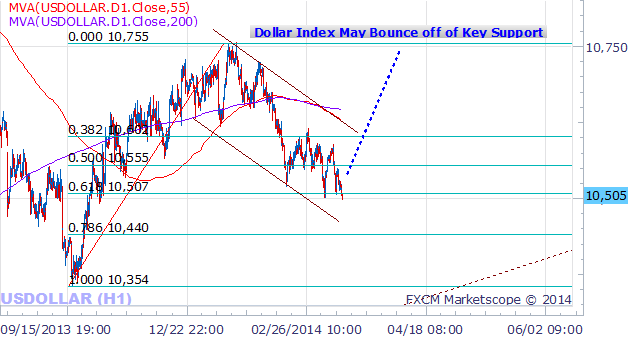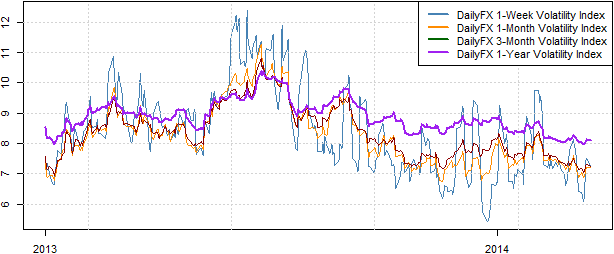US Dollar Set up for Trade Opportunities at Key Technical Levels
- US Dollar continues to hold key support as forex volatility slows
- A Euro key reversal suggests that the next move might be lower
- We’ll need to see a material shift in market conditions to favor a Dollar breakdown
The Dollar is setting up for a bounce off of key support levels, but how might we trade the USD, Euro, and other currencies in the week ahead?
A sharp slowdown in forex market volatility suggests that the US currency is likely to hold key lows across the board. Indeed the Euro has failed to break above a key long-term technical level versus the Greenback.
The Dow Jones FXCM Dollar Index continues to hold up at a similarly significant technical support line, and it might ultimately take a major catalyst to force the larger Dollar breakdown.
DJ FXCM Dollar Index Testing Significant Support Level, Potential Make-or-Break Mark

Source: FXCM Trading Station Desktop, Prepared by David Rodriguez
In terms of trading strategy, the sharp drop in volatility prices favors buying the Greenback at key lows and selling it at short-term highs. Our Senior Technical Strategist highlights a Euro key reversal at the highs as a sign price could continue lower; a hold above $1.3815 keeps the broader uptrend intact.
Our trading strategy outlook could materially change if we see an uptick in volatility expectations. Yet FX options traders have sent volatility prices to their lowest levels since the onset of the financial crisis in 2007/2008.
Forex Volatility Prices Continue onto Fresh Multi-Year Lows

Source: OTC FX Options Prices from Bloomberg; DailyFX Calculations
We’ll look to major technical levels at which to buy and sell the US currency through the foreseeable future. In terms of our automated trading strategies, we’re scaling back on our trend-following and volatility-friendly systems until further notice. That said, the table below highlights which trading strategies we think may do well in the days ahead. Sign up for future e-mail updates via my distribution list.
DailyFX Individual Currency Pair Conditions and Trading Strategy Bias


Automate our SSI-based trading strategies via Mirror Trader free of charge
--- Written by David Rodriguez, Quantitative Strategist for DailyFX.com
To receive the Speculative Sentiment Index and other reports from this author via e-mail, sign up to David’s e-mail distribution list via this link.
Contact David via Twitter at http://www.twitter.com/DRodriguezFX
Definitions
Volatility Percentile – The higher the number, the more likely we are to see strong movements in price. This number tells us where current implied volatility levels stand in relation to the past 90 days of trading. We have found that implied volatilities tend to remain very high or very low for extended periods of time. As such, it is helpful to know where the current implied volatility level stands in relation to its medium-term range.
Trend – This indicator measures trend intensity by telling us where price stands in relation to its 90 trading-day range. A very low number tells us that price is currently at or near 90-day lows, while a higher number tells us that we are near the highs. A value at or near 50 percent tells us that we are at the middle of the currency pair’s 90-day range.
Range High – 90-day closing high.
Range Low – 90-day closing low.
Last – Current market price.
Bias – Based on the above criteria, we assign the more likely profitable strategy for any given currency pair. A highly volatile currency pair (Volatility Percentile very high) suggests that we should look to use Breakout strategies. More moderate volatility levels and strong Trend values make Momentum trades more attractive, while the lowest Vol Percentile and Trend indicator figures make Range Trading the more attractive strategy.
HYPOTHETICAL PERFORMANCE RESULTS HAVE MANY INHERENT LIMITATIONS, SOME OF WHICH ARE DESCRIBED BELOW. NO REPRESENTATION IS BEING MADE THAT ANY ACCOUNT WILL OR IS LIKELY TO ACHIEVE PROFITS OR LOSSES SIMILAR TO THOSE SHOWN. IN FACT, THERE ARE FREQUENTLY SHARP DIFFERENCES BETWEEN HYPOTHETICAL PERFORMANCE RESULTS AND THE ACTUAL RESULTS SUBSEQUENTLY ACHIEVED BY ANY PARTICULAR TRADING PROGRAM.
ONE OF THE LIMITATIONS OF HYPOTHETICAL PERFORMANCE RESULTS IS THAT THEY ARE GENERALLY PREPARED WITH THE BENEFIT OF HINDSIGHT. IN ADDITION, HYPOTHETICAL TRADING DOES NOT INVOLVE FINANCIAL RISK, AND NO HYPOTHETICAL TRADING RECORD CAN COMPLETELY ACCOUNT FOR THE IMPACT OF FINANCIAL RISK IN ACTUAL TRADING. FOR EXAMPLE, THE ABILITY TO WITHSTAND LOSSES OR TO ADHERE TO A PARTICULAR TRADING PROGRAM IN SPITE OF TRADING LOSSES IS MATERIAL POINTS WHICH CAN ALSO ADVERSELY AFFECT ACTUAL TRADING RESULTS. THERE ARE NUMEROUS OTHER FACTORS RELATED TO THE MARKETS IN GENERAL OR TO THE IMPLEMENTATION.
OF ANY SPECIFIC TRADING PROGRAM WHICH CANNOT BE FULLY ACCOUNTED FOR IN THE PREPARATION OF HYPOTHETICAL PERFORMANCE RESULTS AND ALL OF WHICH CAN ADVERSELY AFFECT ACTUAL TRADING RESULTS. Any opinions, news, research, analyses, prices, or other information contained on this website is provided as general market commentary, and does not constitute investment advice. The FXCM group will not accept liability for any loss or damage, including without limitation to, any loss of profit, which may arise directly or indirectly from use of or reliance contained in the trading signals, or in any accompanying chart analyses.
original source






 Indonesia
Indonesia